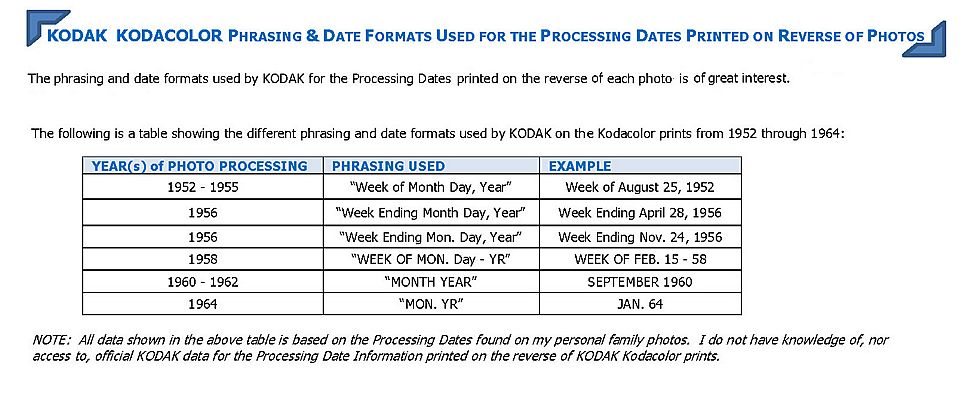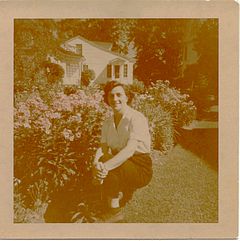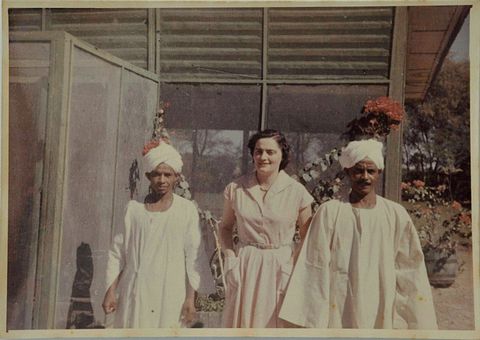|
|
|
|
All the following prints are shown by
courtesy of Angelia McDaniel of Oklahoma, USA. The text below is taken from
Michael Talbert's research, also shown on this web page. Weaver and Long, in their book “A Study of Kodak Color Prints, 1942 – 2008”, state in their time line: “1954 – Magenta stability improved, Coupler Staining Dramatically Reduced, dye order reversed.” Judging from the prints shown below, there is a definite improvement in the colour quality of the February/March 1955 prints and these were almost certainly made on Kodacolor III Type 1348, introduced in 1954. The residual colours are more magenta than in the previous prints. It was the cyan and yellow dyes in prints made in the mid-1950s to 1961 that faded most quickly in sunlight, giving the prints a resultant magenta cast. Much the same could be said about Agfacolor prints made during the same period. Very generally, Kodak prints made between 1954 and 1961 now look magenta, while Agfacolor prints now look red. There are exceptions, depending on how and where the prints are stored. Kodacolor III paper Type 1384 brought about a marked improvement. Although Kodak introduced two other colour papers in the late 1950s (improved versions of Kodak Color Print Material, Type C), it was Ektacolor paper Type 1583 from 1962 which gave a substantial improvement in colour dye stability, especially for greens. Yellowing was virtually eliminated. By 1962, it was the yellow dye that faded more than the green dye, leaving prints (made then) now appearing slightly blue. Agfacolor papers were arguably less stable than Kodak at this time, and it was Agfacolor MCN III Type 4 paper introduced in 1972, that was the first to approach the dye stability of Kodak’s Ektacolor papers. |
|
 |
|
 |
August 1952 to May 1953 They show a definite yellowing of all colors over the entire picture which has occurred in the past 67 - 69 years. Repeating information taken from my Kodacolor web page: Kodacolor Type II paper was introduced in 1950. It was very similar to Type I, but had an ultra violet (UV) absorbing layer above the emulsion layers. Kodacolor Type III paper superseded Type II in 1952 and was used for enlargements and prints from Kodacolor negatives. The paper contained a new magenta coupler. The Kodacolor print below was
made in August 1952 and belongs to Michael Talbert. It seems
unique in being in such good condition. Henry Wilhelm says in
his book 'The Performance and Care of Color Photographs', that
he knows of not a single Kodacolor print taken from 1942 to 1953
that survives in reasonable condition. All have faded and developed
an ugly, overall orange or yellow stain, regardless of whether
they were exposed to light or kept in the dark in albums. Michael
Talbert believes this print is most likely on Kodacolor Type
III paper, before the improved version 1348. "It hasn't
faded to sepia/brown yet". |
 |
August 1953 to January 1954 Below, for comparison, are similar dated prints on Agfacolor paper. The upper print is believed to have been more exposed to light during the intervening years than the lower print, which was kept in an an album. The album print is more magenta/blue. The different storage of the prints is likely to have contributed to their change of colour and the amount of fading. These early Agfacolor prints don't show 'thermal yellowing' nearly as badly as early Kodacolor prints.
|
 |
February 1955 Kodacolor
III Type 1348 paper The prints alongside were probably made on Type 1348 paper and show an improvement of colour quality compared to the previous. Angelia comments ".....still shows a yellowing of the photo after 63 to 66 years of deterioration, but the yellow is not as dark as in earlier prints. Also at this time, the magenta is becoming more prominent.
The pictures alongside can also be seen here. |
 |
April 1956 to February 1958 Kodak Color
Print Material Type C
was marketed from August 1955 Notice that, despite Kodacolor paper being renamed Ektacolor paper, the identification marking on the reverse of the prints continue to refer to KODACOLOR PRINT right through to those made in January 1964. |
 |
September 1960 to January 1961 By 1961 KODAK seem to have finally hit upon a combination of papers, chemicals, equipment, and processes that produced a developed print that would maintain the majority of its colours - even after 57 to 60 years of deterioration. The 1960/61 prints are most likely on Ektacolor Paper Type 1502, introduced in 1959, thought to have been introduced with its emulsion layers sufficiently 'hard' to enable its processing to be carried out at 85°F, in the P-122 processing chemicals. |
 |
June 1962 to January 1964 By the mid-1960’s, KODAK KODACOLOR photos were able to not only retain their original colors - but retain them vividly, brightly and with a high degree of clarity - even after 60 years of deterioration. Ektacolor Paper Type 1502 was followed by Ektacolor Paper Type 1583 in 1962. |
 |
|
|
|
|
|
|
|



